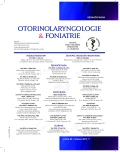-
Medical journals
- Career
Histological and Histochemical Analysis of Retraction Pocket Pars Tensa of Tympanic Membrane in Children
Authors: M. Urík 1,2; P. Hurník 3,4,5; D. Žiak 3,5; J. Macháč 1,2; I. Šlapák 1,2; O. Motyka 6; O. Vaculová 3
Authors‘ workplace: Klinika dětské otorinolaryngologie, Lékařská fakulta, Masarykova univerzita, Brno 1; Fakultní nemocnice Brno 2; Ústav patologie, Fakultní nemocnice Ostrava 3; Ústav patologie, Lékařská fakulta, Ostravská univerzita, Ostrava 4; CGB laboratoř, a. s., Ostrava-Vítkovice 5; Centrum nanotechnologie, VŠB, Technická univerzita Ostrava 6
Published in: Otorinolaryngol Foniatr, 66, 2017, No. 1, pp. 35-39.
Category: Original Article
Overview
Aims:
Histological and histochemical analysis of retraction pocket of pars tensa of tympanic membrane in children. Identification of morphological abnormalities in comparison with a healthy tympanic membrane was investigated as well as identification of signs typical for cholesteatoma and support for a retraction theory of cholesteatoma formation.Study design:
A prospective study analyzing 31 samples of retraction pockets taken during surgery. Departments: University Hospital, Children’s Medical Centre.Methods:
Samples of retraction pockets were processed by a standard process for light microscopy, stained by hematoxilin-eosin. Van Gieson’s stain was used for differential staining of collagen, Verhoeff’s stain for elastic fiber tissues, Alcian blue for acidic polysaccharides and PAS (Periodic Acid Schiff) method for basement membrane polysaccharides.Results:
The following findings were observed in the samples of retraction pockets: 1 hyperkeratosis (100 %), 2 hypervascularisations (100 %), 3 subepithelial fragmented elastic fibres (96 %), 4 myxoid changes (87 %), 5 subepithelial inflammatory infiltration (84 %) 6 rete pegs (71 %), 7 papillomatosis (71 %) 8 intraepithelial inflammatory cellularizations (48 %), 9 intraepithelial spongiosis (16 %) and 10 parakeratosis (3 %). No basement membrane continuity interruptions were observed. Length and thickness of retraction pocket, thickness of epidermis, occurrence of rete pegs and frequency of fragmented elastic fibres was higher in a grade III than grade II (according to Charachon).Conclusion:
Morphological abnormalities in the structure of retraction pockets in comparison with a healthy tympanic membrane were described. The changes are typical for a structure of cholesteatoma, supporting retraction theory of its origin. Our observations show that it is inflammation that plays a key role in the pathogenesis of retraction pocket. The frequency of some of the changes increases with the stage of retraction pocket (II-III according to Charachon). Basement membrane continuity interruptions are not typical for retraction pockets.Keywords:
retraction pockets, histological analysis, cholesteatoma, children
Sources
1. Bluestone, C. D.: Eustachian tube: structure, function, role in otitis media. 1st ed. Hamilton: BC Decker, 2005, 219 s. ISBN 15-500-9066-6.
2. Bluestone, Ch. D., Klein, J.: Pediatric otolaryngology. 4th ed. Philadelphia: WB Saunders, 2003, 1842 s. ISBN 07-216-9197-8.
3. Bunne, M., Falk, B., Magnuson, B., Hellstrom, S.: Variability of Eustachian tubefunction: comparison of ears with retraction disease and normal ears. Laryngoskope, 110, 2000, s. 1389-1395.
4. Gerber, M. J., Mason, J. C., Lambert, P. R.: Hearing results after primary cartilage tympanoplasty. Laryngoskope, 110, 2000, s. 1994-1999.
5. Holmquist, J., Renvall, U., Svendsen, P.: Eustachian tube function and retraction of the tympanic membrane. Ann. Otol. Rhinol. Laryngol., 89, 1980, s. 65-66.
6. Chrobok, V., Pellant, A., Profant, M.: Cholesteatom spánkové kosti. 1. vyd., Havlíčkův Brod: Tobiáš, 2008, 315 s. Medicína hlavy a krku. ISBN 978-80-7311-104-5.
7. Kuijpers, W., Van Der Beek, J M: H., Jap, P. H. K.: Experimental model for study of otitis media with effusion. Acta Otolaryngol., 37, 1983, s. 135-137.
9. Rutledge, C., Thyden, M.: Mapping the histology of the human tympanic membrane by spatial domain optical coherence tomography [online]. Worcester Polytechnic Institute, 2012 [cit. 2016-02-24]. Dostupné z: https://www.wpi.edu/Pubs/E-project/Available/E-project-042412-121551/unrestricted/Thyden,_Rutledge_-_final_MQP_paper.pdf.
9. Sadé, J.: Atelectatic tympanic membrane: histologic study. Ann. Otol. Rhinol .Laryngol., 102, 1993, s. 712-716.
10. Shunyu, N. B., GUPTA, S. D., THAKAR, A., SHARMA, S. C.: Histological and Immunohistochemical study of pars tensa retraction pocket.otolaryngology. Head and Neck Surgery, 145, 2011, 4, s. 628-634.
11. Sudhoff, H., Tos, M.: Pathogenesis of cholesteatoma: clinical and immunohistochemical support for combination of retraction theory and proliferation theory. Am. J.. Otol., 21, 2000, s. 786-792.
12. Sudhoff, H., Tos, M.: Pathogenesis of sinus cholesteatoma. Eur. Arch. Otorhinolaryngol., 264, 2007, s. 1137-1143.
13. Tos, M., Poulsen, G.: Attic retractions following secretory otitis. Acta Otolaryngol., 89, 1980, s. 479-486.
14. Tos, M.: Experimental tubal obstruction. Acta Otolaryngol., 92, 1981, s. 51-61.
15. Yoon, T. H., Schachern, P. A., Paperalla, M. M.: Pathology and pathogenesis of tympanic membrane retraction. Am. J. Otolaryngol., 11, 1990, s. 10-17.
Labels
Audiology Paediatric ENT ENT (Otorhinolaryngology)
Article was published inOtorhinolaryngology and Phoniatrics

2017 Issue 1-
All articles in this issue
- Plain Radiography of Paranasal Sinuses: Its Value in Diagnosis of Acute Rhinosinusitis and Current Possible Indications
- Deep Neck Infections as a Complication of Pharyngeal Inflammation
- Middle Ear Reconstruction in Child
- Microbial Colonization of Upper Respiratory Pathways and Immunity in Children with Adenoid Vegetation
- New Risk Factors for Respiratory Papillomatosis
- Verification of the Impact of Hyperbaric Oxygen Therapy in the Treatment of Sudden Sensorineural Hearing Loss
- Histological and Histochemical Analysis of Retraction Pocket Pars Tensa of Tympanic Membrane in Children
- Surgical Complications in Our First 100 Implanted Patients in ENT Department University Hospital in Košice
- Otorhinolaryngology and Phoniatrics
- Journal archive
- Current issue
- Online only
- About the journal
Most read in this issue- Plain Radiography of Paranasal Sinuses: Its Value in Diagnosis of Acute Rhinosinusitis and Current Possible Indications
- Deep Neck Infections as a Complication of Pharyngeal Inflammation
- Histological and Histochemical Analysis of Retraction Pocket Pars Tensa of Tympanic Membrane in Children
- Verification of the Impact of Hyperbaric Oxygen Therapy in the Treatment of Sudden Sensorineural Hearing Loss
Login#ADS_BOTTOM_SCRIPTS#Forgotten passwordEnter the email address that you registered with. We will send you instructions on how to set a new password.
- Career

